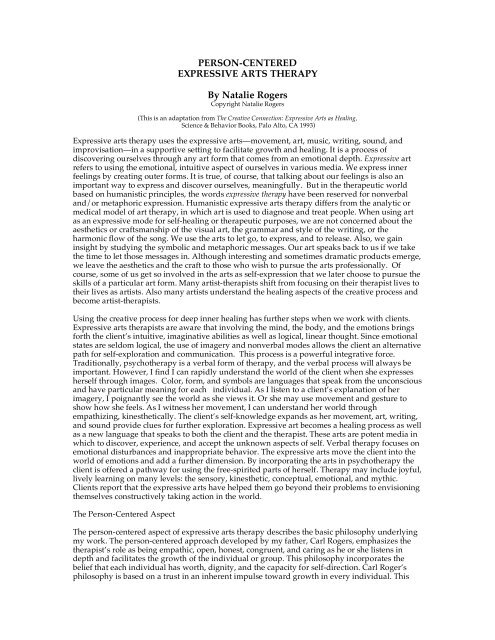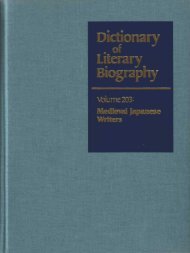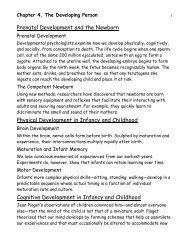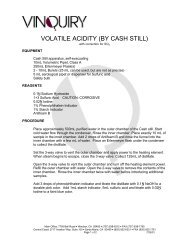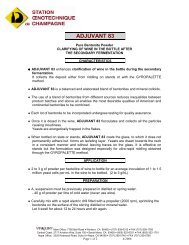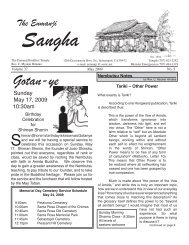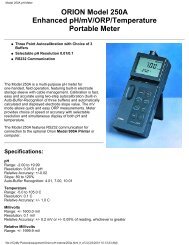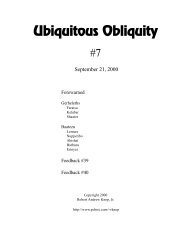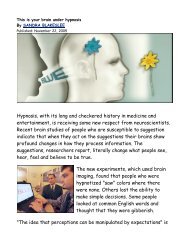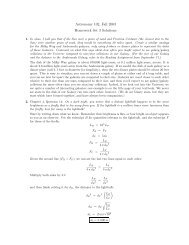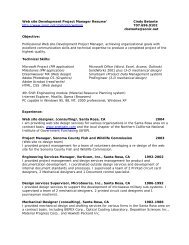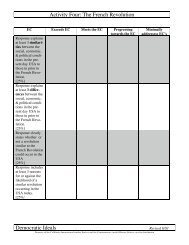Person-centered expressive arts therapy by natalie rogers - Sonic.net
Person-centered expressive arts therapy by natalie rogers - Sonic.net
Person-centered expressive arts therapy by natalie rogers - Sonic.net
Create successful ePaper yourself
Turn your PDF publications into a flip-book with our unique Google optimized e-Paper software.
PERSON-CENTERED<br />
EXPRESSIVE ARTS THERAPY<br />
By Natalie Rogers<br />
Copyright Natalie Rogers<br />
(This is an adaptation from The Creative Connection: Expressive Arts as Healing,<br />
Science & Behavior Books, Palo Alto, CA 1993)<br />
Expressive <strong>arts</strong> <strong>therapy</strong> uses the <strong>expressive</strong> <strong>arts</strong>—movement, art, music, writing, sound, and<br />
improvisation—in a supportive setting to facilitate growth and healing. It is a process of<br />
discovering ourselves through any art form that comes from an emotional depth. Expressive art<br />
refers to using the emotional, intuitive aspect of ourselves in various media. We express inner<br />
feelings <strong>by</strong> creating outer forms. It is true, of course, that talking about our feelings is also an<br />
important way to express and discover ourselves, meaningfully. But in the therapeutic world<br />
based on humanistic principles, the words <strong>expressive</strong> <strong>therapy</strong> have been reserved for nonverbal<br />
and/or metaphoric expression. Humanistic <strong>expressive</strong> <strong>arts</strong> <strong>therapy</strong> differs from the analytic or<br />
medical model of art <strong>therapy</strong>, in which art is used to diagnose and treat people. When using art<br />
as an <strong>expressive</strong> mode for self-healing or therapeutic purposes, we are not concerned about the<br />
aesthetics or craftsmanship of the visual art, the grammar and style of the writing, or the<br />
harmonic flow of the song. We use the <strong>arts</strong> to let go, to express, and to release. Also, we gain<br />
insight <strong>by</strong> studying the symbolic and metaphoric messages. Our art speaks back to us if we take<br />
the time to let those messages in. Although interesting and sometimes dramatic products emerge,<br />
we leave the aesthetics and the craft to those who wish to pursue the <strong>arts</strong> professionally. Of<br />
course, some of us get so involved in the <strong>arts</strong> as self-expression that we later choose to pursue the<br />
skills of a particular art form. Many artist-therapists shift from focusing on their therapist lives to<br />
their lives as artists. Also many artists understand the healing aspects of the creative process and<br />
become artist-therapists.<br />
Using the creative process for deep inner healing has further steps when we work with clients.<br />
Expressive <strong>arts</strong> therapists are aware that involving the mind, the body, and the emotions brings<br />
forth the client’s intuitive, imaginative abilities as well as logical, linear thought. Since emotional<br />
states are seldom logical, the use of imagery and nonverbal modes allows the client an alternative<br />
path for self-exploration and communication. This process is a powerful integrative force.<br />
Traditionally, psycho<strong>therapy</strong> is a verbal form of <strong>therapy</strong>, and the verbal process will always be<br />
important. However, I find I can rapidly understand the world of the client when she expresses<br />
herself through images. Color, form, and symbols are languages that speak from the unconscious<br />
and have particular meaning for each individual. As I listen to a client’s explanation of her<br />
imagery, I poignantly see the world as she views it. Or she may use movement and gesture to<br />
show how she feels. As I witness her movement, I can understand her world through<br />
empathizing, kinesthetically. The client’s self-knowledge expands as her movement, art, writing,<br />
and sound provide clues for further exploration. Expressive art becomes a healing process as well<br />
as a new language that speaks to both the client and the therapist. These <strong>arts</strong> are potent media in<br />
which to discover, experience, and accept the unknown aspects of self. Verbal <strong>therapy</strong> focuses on<br />
emotional disturbances and inappropriate behavior. The <strong>expressive</strong> <strong>arts</strong> move the client into the<br />
world of emotions and add a further dimension. By incorporating the <strong>arts</strong> in psycho<strong>therapy</strong> the<br />
client is offered a pathway for using the free-spirited p<strong>arts</strong> of herself. Therapy may include joyful,<br />
lively learning on many levels: the sensory, kinesthetic, conceptual, emotional, and mythic.<br />
Clients report that the <strong>expressive</strong> <strong>arts</strong> have helped them go beyond their problems to envisioning<br />
themselves constructively taking action in the world.<br />
The <strong>Person</strong>-Centered Aspect<br />
The person-<strong>centered</strong> aspect of <strong>expressive</strong> <strong>arts</strong> <strong>therapy</strong> describes the basic philosophy underlying<br />
my work. The person-<strong>centered</strong> approach developed <strong>by</strong> my father, Carl Rogers, emphasizes the<br />
therapist’s role as being empathic, open, honest, congruent, and caring as he or she listens in<br />
depth and facilitates the growth of the individual or group. This philosophy incorporates the<br />
belief that each individual has worth, dignity, and the capacity for self-direction. Carl Roger’s<br />
philosophy is based on a trust in an inherent impulse toward growth in every individual. This
very deep faith in the innate capacity of each person to reach toward his or her full potential is<br />
the foundation for my approach to <strong>expressive</strong> <strong>arts</strong> <strong>therapy</strong>. Carl’s research into the<br />
psychotherapeutic process revealed that when a client felt accepted and understood, healing<br />
occurred. It is a rare experience to feel accepted and understood when you are feeling fear, rage,<br />
grief, or jealousy. Yet it is this very acceptance and understanding which heals. As friends and<br />
therapists, we frequently think we must have an answer or give advice. However, a very basic<br />
truth is often overlooked. By genuinely hearing the depth of the emotional pain and respecting<br />
the individual’s ability to find her own answer, we are giving her the greatest gift. Empathy and<br />
acceptance give the individual the opportunity to empower herself and discover her unique<br />
potential.<br />
The Creative Connection®<br />
I am intrigued with what I call the Creative Connection—the enhancing interplay among<br />
movement, art, writing, and sound. Moving with awareness, for example, opens us to profound<br />
feelings, which can then be expressed in color, line, or form. When we write immediately after<br />
the movement and art, there is a free flow—sometimes poetry—that emerges. The creative<br />
connection stimulates self-exploration. It is like the unfolding petals of a lotus blossom on a<br />
summer day. In the warm, accepting environment, the petals begin to open to reveal the<br />
blossom’s inner essence. As our feelings are tapped, they become a resource for further selfunderstanding<br />
and creativity. We gently allow ourselves to awaken to new possibilities. With<br />
each opening, we may deepen our experience. When we reach our inner core, we find our<br />
connection to all beings. We create to connect to our inner source and to reach out to the world<br />
and the universe. Some writers, artists, and musicians are already aware of the creative<br />
connection. If you are one of those, you may say, “of course, I always put on music and dance<br />
before I paint.” Or, as a writer, you may go for a long walk before you sit at your desk. However,<br />
you are not alone if you are one of the many in our society who says, “I'm not creative.” I hope<br />
this article entices you to try new experiences. You will surprise yourself.<br />
Innate Creativity<br />
I believe we are all capable of being profoundly, beautifully creative whether we use that<br />
creativity to relate to family or to paint a picture. The seeds of much of our creativity come from<br />
the unconscious and our feelings and intuition. The unconscious is our deep well. Most of us<br />
have put a lid over that well. Feelings can be constructively channeled into creative ventures: into<br />
dance, music, art, or writing. When our feelings are joyful, the art form uplifts. When our feelings<br />
are violent or wrathful, we can transform them into powerful art rather than venting them on the<br />
world. Such art helps us accept that aspect of ourselves. Self-acceptance is paramount to<br />
compassion for others. I discovered personal healing for myself as I combined my interests in<br />
psycho<strong>therapy</strong>, art, dancing, writing, and music. <strong>Person</strong>-<strong>centered</strong> <strong>expressive</strong> <strong>therapy</strong> was born<br />
out of my personal integration of the <strong>arts</strong> and the philosophy I had inherited. Through<br />
experimentation I gained insight from my art journal. I doodled, let off steam or played with<br />
colors without concern for the outcome. Because I was unsure, at first, about introducing these<br />
methods to clients, I suggested they try it and then asked them for feedback. They said it was<br />
helpful. Their self-understanding rapidly increased and the communication between us<br />
improved immensely. The same was true as I introduced movement, sound, and free writing for<br />
self-expression. Clients and group participants reported a sense of “freedom to be”. One group<br />
member wrote: “I learned to play again, how to let go of what I ‘know’—my successes,<br />
achievements, and knowledge. I discovered the importance of being able to begin again.”<br />
Another said: “It is much easier for me to deal with some heavy emotions through <strong>expressive</strong><br />
play than through thinking and talking about it.” It became apparent that the creative connection<br />
process fostered integration. It is clearly stated <strong>by</strong> one client who said, “I discovered in exploring<br />
my feelings that I could break through inner barriers/structures that I set for myself <strong>by</strong> moving<br />
and dancing the emotions. To draw that feeling after the movement continued the process of<br />
unfolding.”<br />
Psychological Principles
Since not all psychologists agree with the principles embodied in <strong>expressive</strong> <strong>arts</strong> <strong>therapy</strong>, it<br />
seems important to state them clearly as the foundation of this process of healing and discovery:<br />
• All people have an innate ability to be creative.<br />
• The creative process is healing. The <strong>expressive</strong> product supplies important messages to the<br />
individual. However, it is the process of creation that is profoundly transformative.<br />
• <strong>Person</strong>al growth and higher states of consciousness are achieved through self-awareness,<br />
self-understanding, and insight.<br />
• Self-awareness, understanding, and insight are achieved <strong>by</strong> delving into our emotions.<br />
The feelings of grief, anger, pain, fear, joy, and ecstasy are the tunnel through which we<br />
must pass to get to the other side—to self-awareness, understanding, and wholeness.<br />
• Our feelings and emotions are an energy source. That energy can be channeled into the<br />
<strong>expressive</strong> <strong>arts</strong> to be released and transformed.<br />
• The <strong>expressive</strong> <strong>arts</strong>—movement, art, writing, sounding, music, meditation, and imagery—<br />
lead us into the unconscious. This often allows us to express previously unknown facets<br />
of ourselves, thus bringing to light new information and awareness.<br />
• Art modes interrelate in what I call the Creative Connection®. When we move, it affects<br />
how we write or paint. When we write or paint, it affects how we feel and think. The<br />
Creative Connection® is a process that brings us to an inner core or essence which is our<br />
life force energy.<br />
• A connection exists between our life force—our inner core, or soul—and the essence of all<br />
beings.<br />
• Therefore, as we journey inward to discover our essence or wholeness, we discover our<br />
relatedness to the outer world. The inner and outer become one.<br />
My approach to <strong>therapy</strong> is also based on a person-<strong>centered</strong> theory of individual and group<br />
process:<br />
• <strong>Person</strong>al growth takes place in a safe, supportive environment.<br />
• A safe, supportive environment is created <strong>by</strong> having facilitators (teachers, therapists, group<br />
leaders, parents, colleagues) who are genuine, warm, empathic, open, honest, congruent,<br />
and caring.<br />
• These qualities can be learned best <strong>by</strong> first being experienced.<br />
• A client/therapist, teacher/student, parent/child, wife/husband, or intimate-partners<br />
relationship can be a place to experience these qualities.<br />
• <strong>Person</strong>al integration of the intellectual, emotional, physical, and spiritual occurs <strong>by</strong> taking<br />
time to reflect, critique, and evaluate these experiences.<br />
Summary<br />
<strong>Person</strong>al growth and self-empowerment can be achieved through the <strong>expressive</strong> <strong>arts</strong>.<br />
Our visual art is changed <strong>by</strong> our movement and body rhythm. It is also influenced when we<br />
meditate and become receptive, allowing intuition to be active. Likewise, our movement can be<br />
influenced <strong>by</strong> our visual art and writing, and so forth. All of the creative processes help us find<br />
our inner essence or source. And when we find that inner source, we tap into the universal<br />
energy source, or the collective unconscious, or the transcendental experience.<br />
Natalie Rogers, Ph.D., REAT, offers a Certificate program, Expressive Arts for Healing and Social<br />
Change: A <strong>Person</strong>-Centered Approach at Saybrook Graduate School. (see www.n<strong>rogers</strong>.com) She<br />
is author of Emerging Woman: A Decade of Midlife Transitions (1980) and The Creative Connection:<br />
Expressive Arts as Healing, (1993) and many chapters and articles. Dr. Rogers practiced as a<br />
psychotherapist for 30 years and spent seven summers facilitating workshops with her father,<br />
Carl Rogers. She has led trainings in Europe, Russia, Latin America and Japan. She was awarded<br />
a Life Time Achievement Award from the International Expressive Arts Therapy Association. She<br />
is an artist, a mother of three professional daughters and grandmother of four creative adults.


